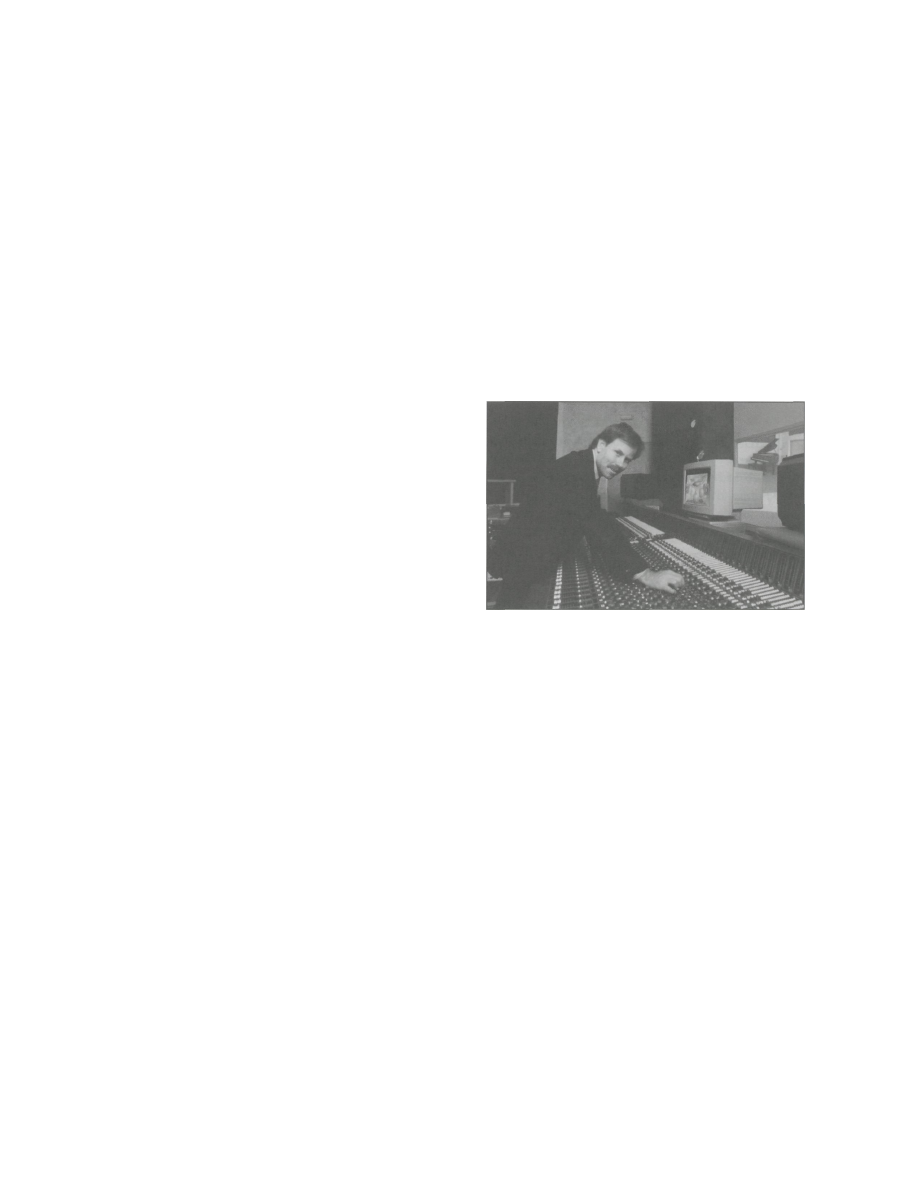ВУЗ: Казахская Национальная Академия Искусств им. Т. Жургенова
Категория: Книга
Дисциплина: Не указана
Добавлен: 03.02.2019
Просмотров: 7433
Скачиваний: 195
116.png)
An especially effective trick is to turn up the
feedback on the delay before it is sent out to the
reverb, then take the delay out of the mix by unas-
signing the mix button (if you simply turn off the
delay channel, it will also turn off the signal going to
the reverb). What you end up with is reverb with a
really long predelay and feedback. It is an extremely
smooth effect that, when put on a vocal, makes it
sound like you have a vocal synth in the background.
Many guitarists, including David Gilmore, like it on
their guitar as well.
Another interesting effect is to send the output
of flanging, chorusing, or phasing to a reverb unit.
This is often much nicer than simply putting these
effects and reverb in the mix.
One of the most interesting combinations of
effects is to send out for fattening (flanging, chorus-
ing) on a sound, and then send the fattening to a 3D
sound processor, surround sound, or multiple speak-
ers. This way you can bring the fattening effect out in
front of the speakers or even behind you.
A similar effect is to send reverb to the 3D sound
processor, surround sound, or multiple speakers. You
can make the reverb sound extremely spacey by
putting it out in front of the console (right in front of
your nose—but in stereo).
One of the most exhilarating effects is to put a
delay with lots of feedback in the 3D sound processor
and use the joystick to rotate it around the room
(what a business we're in, huh?).
There are certainly a huge number of really cool
combinations of effects. See if you can come up with
some new ones on your own. If you come across any-
thing that is death-defying—or just really nice—let
me know (e-mail: virtmixr@hooked.net) and maybe
I'll put it in the next version of the book.
CREATING A CONTEXT OR STYLE OF MIX
By using all of the tools together to create combina-
tions of dynamics, you can create all the different
styles of mixes in the world. One style of mix is the
wall of sound. Just using multiple effects will fill in the
space between the speakers quite well; spreading
sounds in stereo with delays or adding reverb will
quickly fill in every hole in the mix. But, when you
also boost the low end a little on each of the sounds,
they will all take up more space. You can also use pan-
ning to spread sounds in stereo if the two sounds are
similar (like when you have two mics on a guitar
amp); then, when you pan the two sounds completely
left and right, they will pull together so that the
sound is stretched between the speakers—making the
mix much fuller. Panning sounds so that they overlap
a bit makes a stronger wall of sound. If you have very
few sounds in the mix, making the volumes more
even will contribute to a fuller mix. On the other
hand, if you have a really busy arrangement, uneven
volume placement will actually take up more space,
creating a fuller mix.
Visual 220. Making Mix Fuller
Because the main thing that makes a mix full in
the first place is the number of sounds and notes in
the song, you can help make the mix fuller by having
the band play more parts. For example, you might
have the band doubletrack or play the same part
three times. Multiple mics on one sound can also add
to the density of the mix.
As you can see, using all of these techniques
together can build a huge mix. On the other hand, if
you want a mix to be sparser, cleaner, and clearer, do
the opposite: fewer sounds, fewer effects, brighter
EQ, wider panning, and appropriate volume settings.
With these four tools we can create the follow-
ing dynamic patterns. These are some of the emo-
tions and feelings that we can create with the
technical equipment in the studio.
Visual 221. Dynamic Ranges Using 4 Mixing Tools
117
Chapter Six

By changing any of these tools in real time, we
can create additional movement and much more
intense dynamics. And we can use all four tools to cre-
ate an incredibly powerful dynamic.
For example, if you're mixing a love song, you
could set the relative volumes even so that nothing
jumps out and shocks, so that the mood of the emo-
tion is not disturbed. You could set the EQ so that
nothing is too irritating in the midranges, everything
is nice and bright, and there isn't too much bass to
blow the mood. We could set the panning so that it is
balanced. We could use very few effects, so that the
mix is clean and clear. And we could refrain from cre-
ating any unnecessary movement with the faders,
panpots, EQ, or effects so as to not spoil the mood.
Using all of these tools together can create an
intensely beautiful dynamic appropriate for the song.
On the other hand, if you're mixing some wild
rock 'n' roll or exotic techno, you could set uneven
volume relationships, so that we would have soft
sounds followed by loud sounds, creating a very excit-
ing dynamic. ROCK 'N' ROLL!!! You could set EQ to
get lots of highs and lows. And you could EQ some
sounds so that they cut through and are edgy in the
midrange, making the whole mix jump out and grab
your attention, forcing you to dance. You could set
the panning to be unbalanced, creating tension and
making the mix unusual. You could also add several
different effects, making the mix interesting at every
single moment.
Let's have some serious fun. Enough of the sta-
tus quo. We could have things zooming left and right
with panning, volumes going up and down, EQ
changing throughout the mix, and effects and their
parameters going up and down, as well as their para-
meters changing constantly. Using all of these tools
together, we can create an intensely beautiful dynamic
totally appropriate for the song.
These are two extreme types of mixes that we
could create with all of the tools and equipment in
the studio, and all mixers in the world fall between
these two extremes.
CHANGING THE STYLE OF MIX IN THE
MIDDLE OF THE SONG
More intense, however, is when you create a certain
style of mix, then, using the four mixing tools, com-
pletely change all the parameters, creating an
entirely different style.
The rock group Yes did it with "Owner of a
Lonely Heart." They play a screaming electric guitar
sound and, in a single moment, change to a '50s style
recording of a drum set, miked twenty feet away with
a dull EQ. Then all of a sudden, they return to a
screaming guitar/synthesizer type of sound that is
extremely edgy. Sudden changes in multiple mix
parameters can be extremely effective.
Sting also did it with the song "Englishman in
New York." The song goes from a jazzy groove—very
few effects, very clean, small snare sound—to a huge
drum sound with tons of reverb instantly. Then, in a
flash, it is back to the simple, clear jazz mix.
Of course, you can only create such dramatic
mix dynamics if they are appropriate for the song.
This was obviously one of Frank Zappa's favorite tech-
niques, and Mr. Bungle has taken this concept to the
extreme; every 30 seconds, the song and the mix
change completely.
To change the entire mix in a single moment
can be shocking. It can blow people's minds. It can
show people that their reality is just an illusion that
can change at any moment. But best of all, it shows
perspective. It shows people that they don't need to
stay stuck in their current reality. They only need to
put a different mix on the situation.
All the mixes in the world are created with just
these four tools: volume, EQ panning and effects. It's
what you do with them that counts.
118
The Art of Mixing

C H A P T E R 7
The Relationship of Musical
Dynamics Created by Equipment
to the Musical Dynamics Found
in Music and Songs
Now that we have discussed all the dynamics that can
be created with the technical equipment in the stu-
dio, let's return to the basic concept: The art of mixing
is the way in which the dynamics we create with the equip-
ment in the studio interface with the dynamics apparent in
music and songs. You can now begin to explore all the
different relationships between mixing dynamics and
the dynamics that people perceive in music. The trick
is to remember what you did when you find some-
thing that you really liked in a mix.
Remember what you do—especially when what you
do creates magic! After a couple of years of keeping
track of the magic, you become a magician.
Putting It All in Perspective
Now you know what is required of a recording engi-
neer. Besides learning the technical side of the equip-
ment and how to work well with a wide range of
strange, unusual, and wonderful people, a recording
engineer also deals with refining a diverse array of
aspects—even the music itself. The mix is only one of
many aspects that contributes to a great recorded
piece of music.
You've learned many of the details of the
dynamics that can be created with studio equipment.
You now have a mixing framework, designed to in-
clude all of the musical possibilities, to help you get a
good perspective on all that you can do in the studio.
Just as a great musician must, at some point, learn
and incorporate aspects of theory and technique into
his or her actual playing, so must the aspiring recording
engineer incorporate theory into practice. This process
varies for different people. Some people are fanatics
(driven by parents, childhood experiences, or from
something above), will take the bull by the horns and
study until they are blue in the face, and have it all
down. Others will incorporate the aspects that stick out
in their minds the most. One or more ideas will sneak
into your recording projects over the next few months.
You might also reread some sections of this book from
time to time and gather a few more tidbits to incorpo-
rate. Regardless of your style of learning and how you
incorporate this learning into practice, you now have an
overall structure to see all that an engineer does, and
you can focus on what it takes to become great at it.
The trick is to use the dynamics created by the
equipment to enhance, accentuate, highlight, sup-
port, create tension or just let the music itself shine
through (whichever is appropriate for the song and
style of music). The way in which these dynamics
interface with the music is the art of mixing. The art
of the recording engineer is to seek out the relation-
ships between the equipment and the music that are
the best—whether they be magical, beautiful, amaz-
ing, world-changing, people-changing, or just cool.
Don't stop until you get goosebumps.
Different people have different ideas of what
great art is. The point is to develop your own values
about what you think is great art. Then, make it!
119
Chapter Seven

About the Author
David Gibson has been teaching, engineering, and
producing groups in major 24-track studios since
1982 and is the founder and owner of California Re-
cording Institute in San Francisco. Before that, he
taught recording at Cabrillo College in Santa Cruz
for five years. He has been using the concepts and
visuals presented in this book in his classes since
1986.
Previously, Gibson owned a commercial music
production company called Creative Music Services
in Atlanta, Georgia. He has recorded manyjingles for
the Santa Cruz Boardwalk.
David has also done recording for James Brown's
band, Bobby Whitlock (Derek and the Dominoes),
the Atlanta Rhythm Section, and Hank Williams Jr.'s
band, as well as having worked with members of the
Doobie Brothers, LacyJ. Dalton's band, Herbie Han-
cock's band, and It's a Beautiful Day.
Gibson co-produced a double album with Jona-
thon Segel of Camper Van Beethoven and has pro-
duced a variety of other albums ranging from new
age to heavy metal to hip hop and techno music.
Gibson is also the inventor of the patented "Vir-
tual Mixer," which displays a mix visually in real time.
He created a customized version on the Silicon Graph-
ics computer that shows the visuals in 3D with 3D
glasses.
121
About the Author

Appendix A
Dynamics Created by Studio Equipment Categorized by Emotional Effect
The key is to establish a connection between the technical equipment in the studio and the feelings and emo-
tions found in music. The following chart will help you understand this concept. The middle column shows the
tools. Columns two and four show the types of dynamics that can be created with the tools. And columns one
and five show the types of feelings and emotions created by the dynamics.
Mellow Emotions
ordered
structured
even
fun
gothic
stable
normal
romantic
balanced
simple
Positive Values
warmth
peace
love
security
atmosphere
centeredness
Negative Values
boredom
triteness
status quo
commercial
simple
Even volume
relationships with little
variation between each
sound and successive
sounds from song
beginning to end
Natural EQ between all
instruments; they all fit
well together and are
"natural," as if you were
there
Balanced, symmetrical
placement
Dry, clearly EQ'd,
uneffected instruments,
placed in positions in
the mix to be separate
from each other, leaving
"space" between the
sounds
Use of compression
makes the image of the
sound more stable
because it moves less
Volume
Equalization
Panning
Effects
Stabilization vs.
Movement
Volume relationships
that vary drastically
between sounds and
from section to section
Interesting EQ between
instruments calls
attention to particular
ones because they
sound noticeable
"different," unnatural, or
unique
Unbalanced,
asymmetrical placement
Wet, bassy, and "full"
EQ; fattened, thickened,
and delayed sounds,
placed overlapping posi-
tions in the mix, leaving
no "space" unfilled
between the speakers
Panning, changing
volumes, adding or
changing EQ, and
changing effects make
the sounds less stable
Intense Emotions
interesting
exciting
wild
creative
crazy
new
fun
unbalanced
complex
Positive Values
fun
creativity
catharsis
intrigue
perspective apparent
Negative Values
frenetic
crazy
annoying
psychotic
abnormal
122
The Art of Mixing